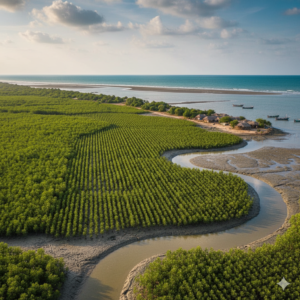 BY SUNEEL KUMAR
BY SUNEEL KUMAR
Once, the coastal belt of Sindh was marked by hardship — rising seas, vanishing mangroves, and struggling fishermen who watched their lands and livelihoods fade away. But along the shores of Keti Bandar, a new chapter has begun. The Delta Blue Carbon Project, one of the world’s largest mangrove restoration initiatives, has not only revived the environment but also breathed life into nearby communities.
What began as an environmental project has now become a model of socioeconomic transformation, offering education, healthcare, clean energy, and jobs — especially for women — in some of the most climate-vulnerable areas of Pakistan.
The Delta Blue Carbon (DBC) initiative, launched in 2015 by the Sindh Forest Department covers vast tracts of the Indus Delta. While its primary goal is to restore mangrove ecosystems and generate carbon credits, the project’s social impact has gone far beyond environmental targets.
In Keti Bandar and its surrounding villages, hundreds of families now depend on DBC-related activities for their livelihood. Men and women are engaged in mangrove nurseries, planting, and maintenance — turning conservation into a source of empowerment.
Today, around 40 to 50 women work regularly in mangrove nurseries, managing and nurturing young plants until they are ready for plantation. Their workday starts at 7:00 a.m. and continues until 5:00 p.m., with wages provided daily along with essential safety equipment. Since they often work in water, the company supplies life jackets and ensures that medical teams visit them regularly to check for skin issues and infections caused by long exposure to seawater.
These women, many of whom have been involved for over a decade, say the project has given them both income and dignity. During field interviews at Ghanab Village, two women shared their experiences that reflect the human side of the Delta Blue Carbon Project. Phupa, a 45-year-old worker, has been tending mangrove nurseries for ten years. Every morning, she travels nearly an hour to reach the site where she spends the day watering and replanting saplings. “Before this work,” she says, “we had no source of income. Now we earn daily wages and support our families. We are proud to protect our land and sea.”
Similarly, Hajani, aged 40, also from Ghanab Village, shared how the project changed her life. “When the season of plantation begins, we plant the mangroves with our own hands,” she said. “We are given safety jackets and medical checkups. This work has not only given us income but also respect in our community.”
For both women, mangrove restoration has become more than just a job — it’s a source of empowerment, purpose, and stability. For local fishermen, mangrove growth has brought new hope. In the past, during the off-season, fishing would stop completely, leaving them without income. Now, thanks to the thick mangrove cover, they can safely fish closer to shore and even within the mangrove channels. The project has indirectly improved fish stocks, providing better yields and more sustainable fishing conditions. “After mangroves were planted, fish and shrimp started returning,” This revival of marine life has strengthened food security and supported hundreds of coastal families who once feared losing their only source of income.
Beyond environmental restoration, the Delta Blue Carbon Project is making visible investments in local welfare. In one of the nearby schools of Keti Bandar, the company has donated around 20 benches and tables, improving learning conditions for children. It might seem like a small step, but in under-resourced coastal communities, such support has a lasting impact.
Similarly, the Rural Health Center in Keti Bandar recently received a new ambulance from the project management. The vehicle provides emergency transport for patients from remote fishing villages — a facility that was previously unavailable. In addition, solar panels have been distributed among several local households, helping them light their homes and power small appliances. In areas where electricity access is limited, these solar systems symbolize progress and self-reliance. Each of these contributions — from school furniture to ambulances and solar power — reflects how environmental investment can lead to community development.
Perhaps the most significant social transformation has been the inclusion of women in the workforce. Traditionally, women in Sindh’s coastal villages had limited access to paid employment. Today, through the Delta Blue Carbon Project, they have become active contributors to the local economy. The women working in mangrove nurseries have learned planting, watering, and maintenance techniques, developing new skills that give them both financial independence and confidence. Their involvement also inspires younger girls to see a future beyond household duties. As one supervisor explained, “When women earn their own income, they make decisions for their children’s education and health. This project is changing not just the environment, but the mindset of our society.”
The success of the Delta Blue Carbon Project shows that environmental conservation and human development can go hand in hand. By planting over 73,000 hectares of mangroves and engaging thousands of local people, the project is redefining what climate resilience looks like in Pakistan. It proves that when local communities are made partners — not just beneficiaries — real, lasting change takes root. Mangroves not only absorb carbon and protect against storms; they now stand as a symbol of hope, empowerment, and sustainability for Sindh’s coastal population. From providing benches for classrooms to ambulances for hospitals, and from daily wages to women’s dignity, the Delta Blue Carbon Project has turned an environmental goal into a human success story.
